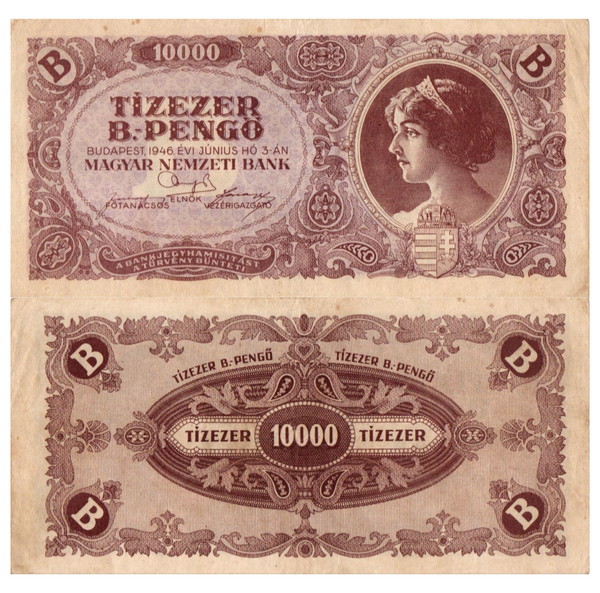-

 - 10%- 10%
- 10%- 10%1946 Hungary 10,000 B-Pengo (10 quadrillion pengo) P-132 Hyperinflation USED ALMOST UNC Banknote
Inc. TaxInc. TaxRRP: Inc. Tax$179.00$199.00RRP:1946 Hungary 10,000 B-Pengo (10 quadrillion pengo) P-132 Hyperinflation USED Banknote The 1946 Hungarian 10,000 B.-Pengő banknote, cataloged as P-132, represents a staggering 10 quadrillion Pengő in... -


1946 HUNGARY 100000 B-PENGO Banknote (100 Quadrillion) P-133 Hyperinflation 1946 RARE UNC
Inc. TaxInc. TaxRRP: Inc. Tax$229.00RRP:1946 HUNGARY 100000 B-PENGO Banknote (100 Quadrillion) P-133 Hyperinflation 1946 UNC Description: Introducing the remarkable 1946 Hungary 100000 B-Pengo Banknote, boasting an astonishing denomination... -

 - 25%- 25%
- 25%- 25%1946 HUNGARY 10 MILLION B-PENGO Banknote (10 Quintillion) P-135 Hyperinflation 1946 UNC
Inc. TaxInc. TaxRRP: Inc. Tax$389.00$517.00RRP:1946 Hungary 10 Million B-Pengo Banknote (10 Quintillion) P-135, Hyperinflation Era, UNC Description: Immerse yourself in the extraordinary world of historic currency with the 1946 Hungary 10 Million... -


1946 Hungarian 10,000,000 Milpengő (10 Trillion Pengo) P-129 Hyperinflation Banknote CRISP UNC NEW
Inc. TaxInc. TaxRRP: Inc. Tax$169.00RRP:1946 Hungarian 10,000,000 Milpengő (10 Trillion Pengo) P-129 Hyperinflation Banknote NEW CRISP UNCIRCULATED VERY RARE IN THIS CONDITION The 1946 Hungarian 10,000,000 Milpengő banknote, cataloged as... -


1945 Hungary 1 Millio Egymillio pengo (1 Million Pengo) Hyperinflation Banknote NEW CRISP UNC
Inc. TaxInc. TaxRRP: Inc. Tax$109.00RRP:This 1945 Hungarian banknote is a striking example of hyperinflation, denominated at 1 million Pengo. Issued on November 16, 1945, by the Magyar Nemzeti Bank, it symbolizes the tumultuous economic...
1946 Hungary 10,000 B-Pengo (10 quadrillion pengo) P-132 Hyperinflation NEW CRISP UNCIRCULATED Banknote
The 1946 Hungarian 10,000 B.-Pengő banknote, cataloged as P-132, represents a staggering 10 quadrillion Pengő in the historical context of hyperinflation. As one of the highest denominations issued before the introduction of the Forint, this banknote encapsulates the unprecedented economic conditions in Hungary at the time, serving as a crucial artifact for understanding the scale of hyperinflation that the country experienced.
Design and Features:
The design of the 10,000 B.-Pengő reflects the intricate and sophisticated approach to banknote design characteristic of the era, despite the economic turmoil. It often features elaborate patterns, national symbols, or portraits of significant figures in Hungarian history, rendered with precision and attention to detail. The banknote's design not only served aesthetic purposes but also incorporated advanced security features to prevent counterfeiting, a significant concern during periods of rapid currency devaluation.
Historical Significance:
This banknote highlights the peak of Hungary's hyperinflation crisis in 1946, a period marked by the world's highest inflation rate recorded. The issuance of the 10,000 B.-Pengő note illustrates the Hungarian government's struggle to maintain a functional economy and the desperate measures taken to keep pace with the inflation spiral. It precedes the monetary reform that introduced the Forint, aimed at stabilizing the economy and restoring public confidence in the national currency.
Collector's Value:
To collectors, the 10,000 B.-Pengő banknote is not merely a piece of currency but a historical document that narrates the story of economic adversity and resilience. Its rarity and the extreme historical context of its issuance make it a prized possession among those interested in the phenomena of hyperinflation, monetary history, and the socio-economic challenges of post-war Europe.




